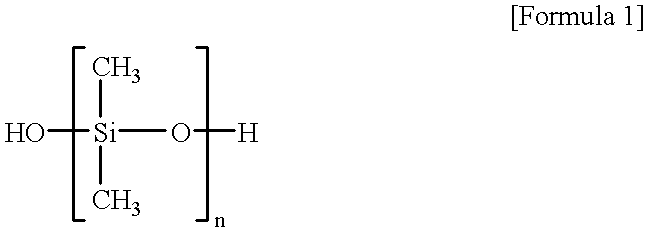Amino acid silicon polymer, method for preparing the same, cosmetic particles surface-treated with the same, and cosmetic composition containing the particles
a technology of silicon polymer and acidic silicon, which is applied in the field of acidic silicon polymer, which can solve the problems of cosmetic particles coming undone off the skin, low oil resistance of cosmetic particles, and skin troubles
- Summary
- Abstract
- Description
- Claims
- Application Information
AI Technical Summary
Problems solved by technology
Method used
Image
Examples
experimental example 1
Measurement of Zeta Potential
Zeta potentials of the respective products of Embodiments 16 and 17 and Comparative Examples 1 to 4 were measured with an ELS-8000 (Photal) zeta potentiometer under the neutrality condition and the weak acid condition of pH=5.5 similar to the skin condition, so as to analyze the products in regard to their electrostatic affinity to the skin. The results are shown in Table 3.
As understood from the zeta potentials of the pigment surface as shown in Table 3, the surface charges of all samples excepting those of Comparative Example 1 (i.e., non-surface-treated particles) were positive at the pH of the skin.
The samples of Comparative Example 1 (i.e. non-surface-treated particles) and Comparative Example 2 (i.e., silicon-treated particles) had negative surface charges. From this, it can be expected that the products of Comparative Examples 1 and 2 have their affinity to the skin deteriorated. The particles surface-treated with amino acids as prepared in Compar...
experimental example 2
Test for Adhesion to Keratin
Adhesions to the outermost layer of the skin, keratin layer were measured with a Seishin MT-1000 instrument for measuring physicochemical properties of particles, for the respective samples of Embodiments 16 and 17 and Comparative Examples 1 to 4 and for the samples prepared by mixing the above samples with keratin particles at the ratio of 1:1. The measurement was performed in such a manner that the sample powder of a predetermined volume was dropped several times by a predetermined force and the decreased volume of the sample powder was measured. The measured values were used to calculate an adhesion coefficient 1 / b according to the Kitakawa equation [N / C=(1 / ab)+(1 / a)N, where N is the number of tapping time; C is a ratio of volume reduction; "a" is a coefficient representing most-densely-filled specific volume].
Here, the adhesion coefficient of the sample alone represents particle-particle adhesion and the adhesion coefficient of the sample-keratin mixt...
experimental example 3
Test for Water Resistance
Procedures for measuring water resistance of the samples of Embodiments 16 and 17 and Comparative Examples 1 to 4 were performed as follows.
100 g of an aqueous solution of acetone was added to a 100 ml beaker. The composition of the acetone was adjusted in terms of weight %. A sample to be measured was dropped in a small amount to form a thin particle layer on the surface of the solution, and pulses were applied with a Seishin IH-2000 horizontal pulse oscillator. Here, while varying the amount of the acetone by 1 g, the weight ratio of the acetone was measured when the sample is dropped into the solution, during oscillation of 1 minute. When the particles start to disperse, the surface tension of the aqueous solution of acetone can be considered as the critical surface tension of the particles. Thus, the weight ratio of the acetone can be expressed in terms of the water resistance of the sample, This test was repeatedly carried out five times for every sampl...
PUM
| Property | Measurement | Unit |
|---|---|---|
| melting point | aaaaa | aaaaa |
| boiling point | aaaaa | aaaaa |
| temperature | aaaaa | aaaaa |
Abstract
Description
Claims
Application Information
 Login to View More
Login to View More - R&D
- Intellectual Property
- Life Sciences
- Materials
- Tech Scout
- Unparalleled Data Quality
- Higher Quality Content
- 60% Fewer Hallucinations
Browse by: Latest US Patents, China's latest patents, Technical Efficacy Thesaurus, Application Domain, Technology Topic, Popular Technical Reports.
© 2025 PatSnap. All rights reserved.Legal|Privacy policy|Modern Slavery Act Transparency Statement|Sitemap|About US| Contact US: help@patsnap.com



